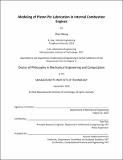Modeling of piston pin lubrication in internal combustion engines
Author(s)
Meng, Zhen,Ph.D.Massachusetts Institute of Technology.
Download1227042294-MIT.pdf (9.344Mb)
Other Contributors
Massachusetts Institute of Technology. Department of Mechanical Engineering.
Advisor
Tian Tian.
Terms of use
Metadata
Show full item recordAbstract
The piston pin joins the piston and the connecting rod to transfer the linear force on the piston to rotate the crankshaft that is the eventual power outlet of the engine. The interfaces between the piston pin and the pin bore as well as the connecting rod small end are one of the most heavily loaded tribo pairs in engines. Piston pin seizure still occurs often in the engine development and the solution often comes from applying expensive coatings. Furthermore, it has been found that the friction loss associated with the pin can be a significant contributor to the total engine mechanical loss. Yet, there lacks a basic understanding of the lubrication behavior of the pin interfaces. This work is aimed to develop a piston pin lubrication model with consideration of all the important mechanical processes. The model predicts the dynamics of the pin and the lubrication of the interfaces between the pin and pin bore as well as small end. The model couples the dynamics of the pin with the structural deformation of the mating parts, the hydrodynamic and boundary lubrication of all the interfaces, and oil transport. The model is successfully implemented with an efficient and robust numerical solver with the second order accuracy to compute this highly stiff system. The preliminary results applying the model to a gasoline engine show that the boundary lubrication is the predominant contributor to the total friction. As a result, the interface with more asperity contact tends to hold the pin with it. Thus, the pin friction loss is coming from the interface with less contact. Solely from friction reduction point of view, ensuring efficient hydrodynamics lubrication in one interface is sufficient. Furthermore, as the heavy load is supported in several small areas, mechanical and thermal deformation of all the parts are critical to load distribution, oil transport, and the generation of hydrodynamic and asperity contact pressure, providing the necessity of the elements integrated in the model. This work represents the first step to establishing a more comprehensive engineering model that helps the industry understand the pin lubrication and find cost-effective solutions to overcome the existing challenges.
Description
Thesis: Ph. D., Massachusetts Institute of Technology, Department of Mechanical Engineering, 2020 Cataloged from student-submitted PDF of thesis. Includes bibliographical references (pages 120-121).
Date issued
2020Department
Massachusetts Institute of Technology. Department of Mechanical EngineeringPublisher
Massachusetts Institute of Technology
Keywords
Mechanical Engineering.